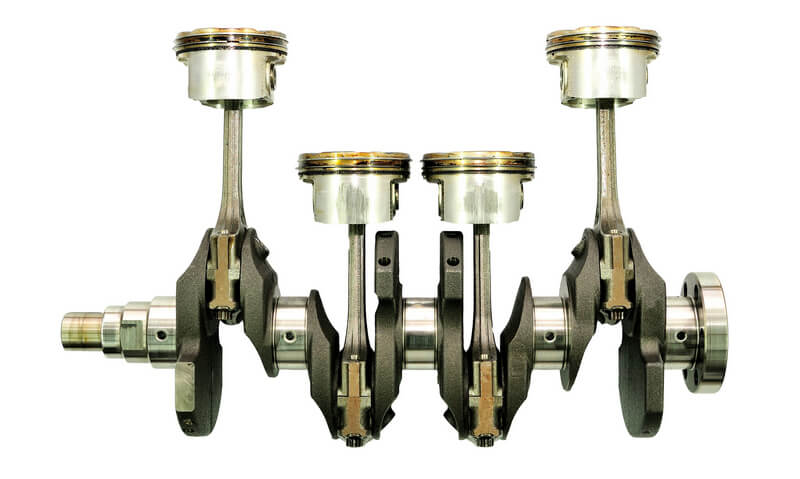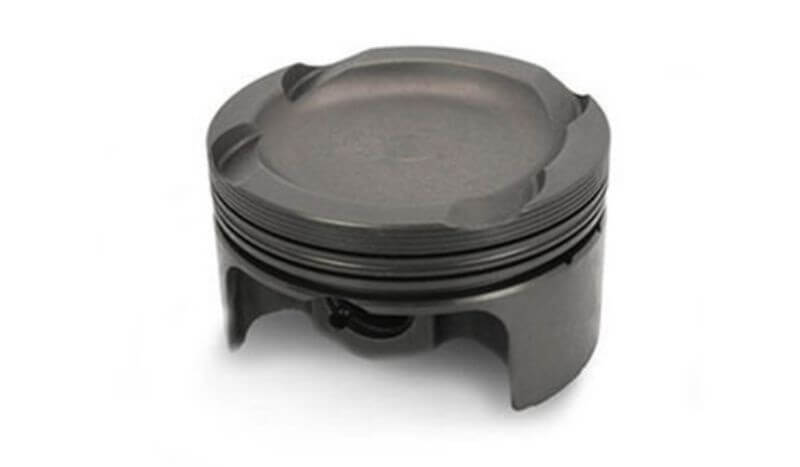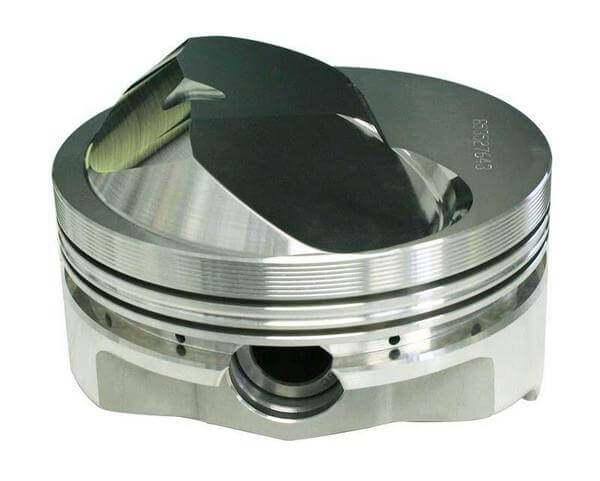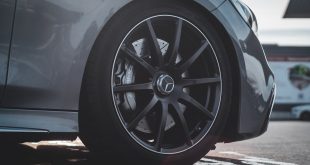Very few engine components are as misunderstood as pistons. Despite offering some of the biggest horsepower and torque gains possible from any upgrade, pistons are typically one of the parts that get put to the end of a list of engine mods. The reason is, in part, that replacing pistons is expensive, difficult, and has the potential to cause massive engine failure if the work isn’t done correctly. Furthermore, due to the numerous options on the market, mismatched parts are frequently installed, causing weird problems down the line.
This article will clear up some of the mystery surrounding these critical engine parts and help you make the right choice when replacing factory pistons with aftermarket components. There are several types of pistons out there, each with a specific purpose. Various manufacturing techniques also make some pistons better suited for specific applications, and even specialized coatings that impact the way your engine runs.

How A Piston Works
Most automotive engines on the market today are of the four-stroke type. What this means in simple terms is that the camshaft rotates four times for every two rotations of the piston, with the intake and exhaust valves opening in time with the movement of the piston. An easy, if not a little dirty, way to remember the four-stroke sequence is: Suck (Intake), Squeeze (Compression), Bang (Combustion), and Blow (Exhaust). Remembering this sequence helps identify where a piston is in its travel course, simply depending on which valves are open or closed.
Download a repair manual for your car here!
Anatomy of a Piston
Regardless of style or type, all pistons share common features. Knowing the names of the parts of a piston and their function can help to differentiate between types of pistons for your application.
The piston’s basic parts are the crown, which is the top surface, the skirt, which is the sides of the piston that support the crown, and the pin, which is where the piston is connected to the connecting rod. Every piston will have between two and four grooves cut around the circumference near the crown. These are known as the ring lands, and they allow a series of metal alloy rings to fit snugly around the piston, preventing the piston from touching the cylinder walls. The rings allow combustion pressure to build up and avoid oil from entering the cylinder from the bottom while keeping the cylinder walls lubricated.
Piston Movement During Engine Cycles

The piston plays a crucial role in the four-stroke sequence. When the intake valve opens, the piston moves down in the cylinder, drawing air and fuel into it. As the piston moves back up, both exhaust and intake valves are closed, creating pressure. The amount of pressure created is largely controlled by the shape of the piston’s top surface and the compression and oil control rings surrounding the piston, holding pressure.
Once the piston reaches near the top of the stroke, the spark plug fires, igniting the compressed air/fuel mixture. The explosion then forces the piston down the cylinder. Once the piston begins to move back up, the exhaust valve opens, allowing the burnt fumes to be pushed out of the combustion chamber.
Why the Piston is Important for Performance
The engine’s overall performance is directly controlled by how well the piston can compress air and fuel, retain pressure, and force gasses out of the cylinder, and the type of piston determines how well the process works. Often, tired and abused engines lose performance because of the piston and rings’ degradation, preventing adequate compression and a lack of power.
And unfortunately, an engine must be completely torn down to replace pistons and rings, which is often why owners get rid of old cars and trucks rather than fix them. It is expensive and challenging work, and for those drivers who lack the time and experience to do the job, it is rarely worth the expense.
Most Common Types of Pistons
It might surprise some drivers to see the various types of pistons available today. In fact, it can be very overwhelming to pick the right ones for your engine upgrade just because of how many different products and price points you have to choose between.
With that being said, picking the right model often comes down to the engine build’s end goal. For example, if the engine is simply a stock replacement rebuild, you will need pistons with factory-type features. If an engine is being built to take advantage of a turbocharger or supercharger, lower compression pistons will be required. Racing engines that are naturally-aspirated need high compression pistons instead to create more power.
Types of Piston Crown Designs
The first part of the piston you’ll need to understand is called the “crown” or the piston’s top surface. It is the part that is exposed to flame. There are essentially three types of pistons in use today, each known simply by the crown’s design.

Flat-top Pistons
Flat-tops are the most common piston design for most applications. And as the name implies, the piston crown is literally flat. This design provides the best balance between compression ratios and valve clearances while also maximizing potential power. Flat-top pistons are common in street cars, race cars, and high-performance engines.

Dished Pistons
A piston with a dished crown is shaped like a bowl. These pistons are typically used for forced induction systems such as turbos and superchargers because they reduce compression. High compression ratios on a forced-induction engine risk literally tearing the engine apart.

Domed Pistons
Domed pistons create a more compact combustion chamber, creating higher compression rates, in theory. However, domed pistons often create other issues, including slow-burning or incomplete combustion, valve interference, and reduced efficiency. This type of piston should only be used in very specific applications.

Valve Reliefs
Valve reliefs are pockets cut into the piston’s crown to prevent the valves from hitting the piston, i.e., engine interference. Reliefs can be found on all types of crown designs but are typically necessary with domed pistons.
Manufacturing Processes
As if all this wasn’t complex enough, the process by which the piston is made can significantly change the application the piston is appropriate for. There are three main types of processes used to produce pistons, each with advantages and drawbacks.
Cast Pistons
Cast pistons are made using a mold into which molten metal – typically aluminum – is poured, and the piston is then shaped on a tool. This process is the least expensive and produces high-quality pistons for most stock or mild street applications. The drawback to cast pistons is they cannot withstand high-compression forces.
Hypereutectic Pistons
These pistons are cast from aluminum with a high amount of silicon alloyed into the metal. Silicon allows for much tighter piston clearances and significantly higher strength over cast pistons and is thus suitable for high-compression engine builds. Hypereutectic is the most common piston manufacturing process for high-performance street engines.
Forged Pistons
Forged pistons are made by machining a solid lump of an alloy rather than casting. This process creates a much more robust piston, capable of withstanding very high compression ratios. However, forged pistons are also much more expensive than other types.
Forged pistons are also commonly used for forced-induction engines where internal cylinder pressure is much higher than naturally-aspirated ones.
Oversized Pistons
It is common when rebuilding an engine to bore the cylinders to remove wear and damage. When this is done, the pistons must be replaced with larger diameter pistons, called “oversized.” These are typically sold in increments of .010″, .030″, and even larger ones that can go up to .065″ or more.
Fitting stock diameter pistons to an overbored engine will result in a massive loss of compression, low power, and oil consumption. Imminent engine failure will inevitably happen. On the other hand, adequately fitted oversized pistons can increase compression ratios and power.
Piston Coatings Options
There are many different types of coatings on the market, many of which make fantastic claims about the performance gains available by coating a piston. However, these claims are often dubious at best. In general, a piston coating can help reduce friction to provide tighter cylinder wall clearances and prevent carbon build-up. Each piston manufacturing company offers its own patented process to coat pistons.
Last Words
Selecting the right piston for your engine build involves more than just ordering whatever will fit in the hole. You’ll need to have an idea about what the long-term goal of an engine is. For example, if the plan is to add a large camshaft to provide extra lift and longer opening duration, a piston with valve reliefs will be required. A supercharged, fuel-injected engine will require dished pistons to prevent pre-detonation. Many short-stroke engines like motorcycle engines can benefit from domed pistons to increase pressure.
Before deciding what piston to buy for your project, you should consider other critical components, most specifically the cylinder heads. Each head will have a maximum amount of pressure it can handle, and specific pistons for aftermarket heads are often necessary to take advantage of the advances in performance you can get from the engine.
In all cases, if you aren’t sure what would be best for your specific build, don’t hesitate to ask for professional advice. Trust me. Choosing the wrong type of pistons for your engine can turn quite ugly real quick.
Download a repair manual for your car here!








